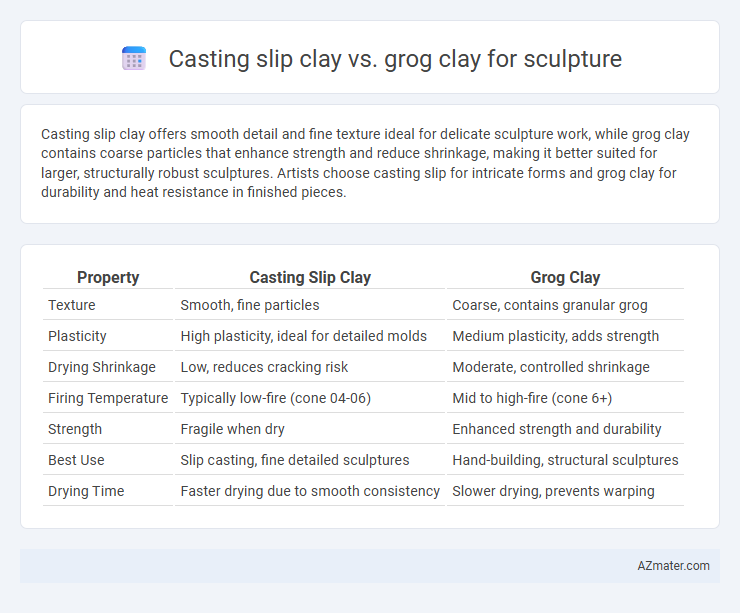Casting slip clay offers smooth detail and fine texture ideal for delicate sculpture work, while grog clay contains coarse particles that enhance strength and reduce shrinkage, making it better suited for larger, structurally robust sculptures. Artists choose casting slip for intricate forms and grog clay for durability and heat resistance in finished pieces.
Table of Comparison
| Property | Casting Slip Clay | Grog Clay |
|---|---|---|
| Texture | Smooth, fine particles | Coarse, contains granular grog |
| Plasticity | High plasticity, ideal for detailed molds | Medium plasticity, adds strength |
| Drying Shrinkage | Low, reduces cracking risk | Moderate, controlled shrinkage |
| Firing Temperature | Typically low-fire (cone 04-06) | Mid to high-fire (cone 6+) |
| Strength | Fragile when dry | Enhanced strength and durability |
| Best Use | Slip casting, fine detailed sculptures | Hand-building, structural sculptures |
| Drying Time | Faster drying due to smooth consistency | Slower drying, prevents warping |
Introduction to Casting Slip Clay and Grog Clay
Casting slip clay is a liquid mixture of clay and water designed for detailed mold casting, offering smooth surfaces and fine detail retention in sculptures. Grog clay incorporates pre-fired, crushed clay particles to increase strength, reduce shrinkage, and enhance texture, making it ideal for large or structurally demanding sculptures. Both materials serve distinct sculptural needs, with casting slip excelling in precision and grog clay providing durability and workability.
Composition Differences: Slip Clay vs. Grog Clay
Slip clay is primarily composed of finely ground, deflocculated clay particles suspended in water, allowing for smooth application and detailed surface finishes in sculpture. Grog clay contains a significant amount of pre-fired clay particles, known as grog, which are added to the clay body to improve strength, reduce shrinkage, and enhance thermal shock resistance during firing. The key compositional difference lies in the presence of coarse grog granules in grog clay, contrasting with the homogenized, slurry-like consistency of slip clay designed for casting and fine detailing.
Workability and Texture Comparison
Casting slip clay offers superior fluidity and smoothness, allowing for intricate detail and easy manipulation when creating fine sculptures. Grog clay, containing pre-fired clay particles, provides a coarse texture that enhances structural strength and reduces shrinkage, making it ideal for larger, more rugged sculptures. Workability varies as casting slip excels in delicate, detailed work while grog clay is better suited for projects requiring durability and textural contrast.
Drying and Shrinkage Rates
Casting slip clay, composed of fine particles and high water content, exhibits slower drying rates and minimal shrinkage, making it ideal for detailed sculpture work with reduced cracking risk. Grog clay contains pre-fired clay particles that promote faster drying and enhance structural stability, resulting in lower overall shrinkage and improved resistance to warping. Understanding the distinct drying behaviors and shrinkage percentages, typically 5-12% for casting slip and 2-7% for grog clay, guides sculptors in selecting materials based on project requirements.
Surface Finish and Detail Retention
Casting slip clay offers a smooth surface finish ideal for intricate detail retention, making it perfect for fine sculptural work requiring precision. Grog clay contains fired clay particles that enhance strength and reduce shrinkage but results in a rougher surface, slightly compromising delicate detail. Sculptors choose casting slip for polished textures and grog clay for durability and structural support.
Durability and Structural Strength
Casting slip clay offers smooth texture and fine detail replication but tends to be less durable and more prone to cracking during drying and firing. Grog clay incorporates pre-fired, crushed clay particles, enhancing structural strength and reducing shrinkage, thus providing superior durability for large or heavy sculptures. Artists seeking long-lasting, robust works often prefer grog clay due to its improved resistance to warping and fracturing under stress.
Firing Temperatures and Performance
Casting slip clay typically fires at lower temperatures, ranging between cone 04 to cone 06 (approximately 1940degF to 1828degF), offering smooth surfaces ideal for detailed sculptures but with lower thermal resistance. Grog clay contains pre-fired clay particles, allowing it to fire at higher temperatures, often cone 5 to cone 10 (about 2167degF to 2345degF), enhancing durability and reducing shrinkage and warping during firing. The inclusion of grog improves structural performance and heat resistance, making it suitable for larger or functional sculptures requiring higher thermal stability.
Ideal Uses for Slip Clay in Sculpture
Slip clay, characterized by its smooth, liquid consistency, is ideal for intricate detailing, joining parts, and creating delicate textures in sculpture. It excels in slip casting techniques where fine surface finishes and precise mold replication are required. Compared to grog clay, which contains coarse particles for strength and texture, slip clay allows for greater flexibility and precision in forming complex shapes and fine artistic elements.
Best Applications for Grog Clay in Art
Grog clay is ideal for large-scale sculptures and functional pottery due to its enhanced strength and reduced shrinkage, which prevent cracking during firing. The coarse grog particles provide excellent texture and improve the clay's workability, making it well-suited for textured surfaces and structural stability in robust artistic pieces. Artists favor grog clay when durability and surface detail are critical, especially in high-fire ceramic art and intricate sculptural forms.
Choosing the Right Clay Type for Your Sculptural Needs
Casting slip clay offers smooth texture and fine detail retention ideal for delicate sculptures, while grog clay contains coarse, pre-fired particles that enhance strength and reduce shrinkage during firing. Selecting the right clay depends on the sculpture's complexity and durability requirements; slip clay excels for intricate, lightweight pieces, whereas grog clay supports larger, more robust forms with improved structural stability. Artists should assess firing temperature compatibility and surface finish preferences to optimize the performance of their chosen clay type.

Infographic: Casting slip clay vs Grog clay for Sculpture
 azmater.com
azmater.com